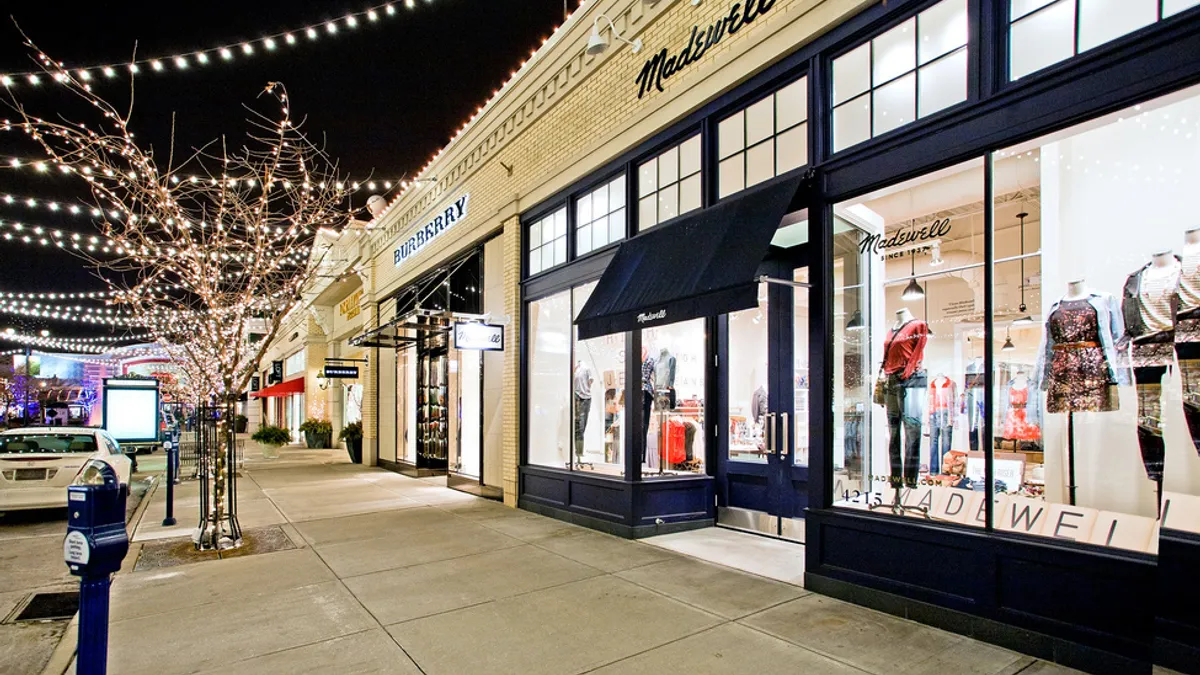Dive Brief:
-
J.Crew Group on Tuesday reported that fourth quarter total revenues rose 2% to $710.6 million, (including $28.6 million generated in the 14th week), and that same-store sales fell 3%, an improvement from the 5% decrease in the year-ago period. The company plans to shutter 20 stores this year.
-
By brand in the quarter, J.Crew sales fell 4% to $547.1 million as same-store sales fell 7%, same as Q4 last year, according to a company press release. Madewell sales rose 32% to $135.8 million as same-store sales surged 17%, following a 6% increase a year ago. Gross margin expanded in the quarter to 36.6% from 34.7% last year.
-
Net losses for the year (which includes a benefit for income taxes of $105.5 million) widened to $125 million from $23.5 million last year, reflecting non-cash impairment charges, transformation costs, transaction costs and severance costs. Adjusted earnings before interest, taxes, depreciation and amortization rose 18% or $33.7 million to $222.2 million from $188.5 million last year.
Dive Insight:
J. Crew appears to have stabilized, but the real story continues to be Madewell, which COO Mike Nicholson said saw record sales growth in stores and online. "The brand’s compelling product offering continues to resonate with customers, delivering strong full price selling led by our denim business," he said on a conference call.
As a result, the company plans to "hyper-scale Madewell’s growth," Nicholson said. The maneuver is clear in J. Crew’s morphing footprint. Last year, it opened eight Maxwell stores, one J. Crew location and one J. Crew factory store evenas it shuttered 51 units. This year, plans are to open 10 Madewell stores, one J. Crew and to close about 20. The brand is also encroaching on J.Crew’s territory, with plans to open Madewell shop-in-shops inside six J.Crew locations in New York City, Florida, Iowa, New Hampshire and Connecticut.
The company is one of the few actually turning to department stores for expansion. Revenues increased last year after the company extended its Madewell and J. Crew shops inside full-line Nordstrom stores, Nicholson said, adding that the company is at the early stages of a global wholesale growth effort.
While Madewell isn’t as low priced as Old Navy, the sibling brand shares an origin story and an evolution similar to the Gap Inc. banner. Not only were both drummed up by Mickey Drexler when he led the companies, but each has also eclipsed the flagship brand. Old Navy last year was elevated in Gap Inc.’s growth strategy, and now J. Crew is staking its comeback on Madewell.
"This is Mickey Drexler/Gap redux," Mark Cohen, director of retail studies at Columbia University's Graduate School of Business, told Retail Dive in an email. "Years ago the mother ship (Gap) started sinking only to be kept afloat by the newborn child (Old Navy). Clearly J. Crew continues to take on water, relying entirely on Madewell to keep the company’s head above water."
But the company will have to scale that banner quickly if it’s to made a dent in sales even as it’s firing on all cylinders. The two major questions hanging over the company now are whether J. Crew itself can bounce back and whether Madewell can grow fast enough to enable the larger enterprise to survive its balance sheet issues, Cohen also said.
J. Crew has been hobbled by debt, which has hamstrung turnaround efforts and forced a debt swap drama last summer. At the end of the fourth quarter, total debt, net of discount and deferred financing costs, was $1.71 billion, up from $1.51 billion at the same point last year. Transaction costs ($36.6 million) and debt repayments ($27 million) drained coffers — cash and cash equivalents were $107.1 million compared to $132.2 million at the end of the fourth quarter last year, the company said.













